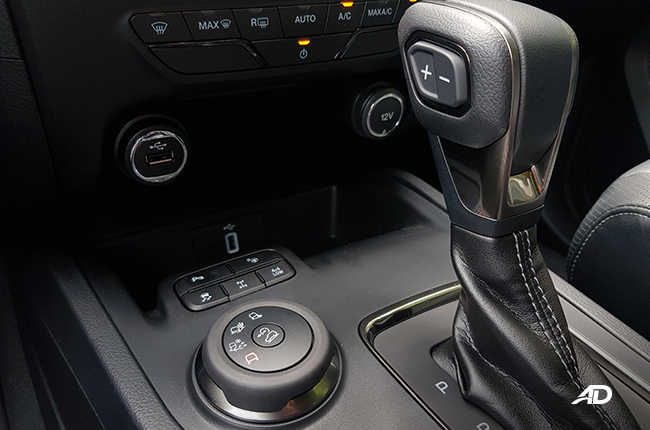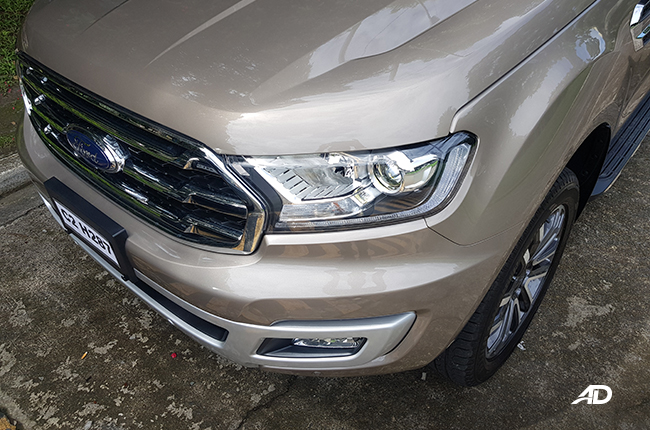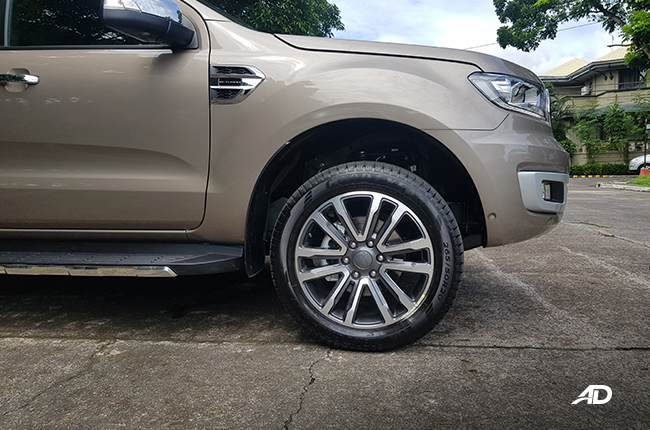
While all of its brothers received updates from Ford Philippines, the SUV sibling of the Ranger family is finally hitting a sort of puberty. This late-bloomer gets mechanical improvements from the trucks, which include an all-new engine and transmission combo. We were given the new Ford Everest in its 2.0L Biturbo Titanium trim for a day. In that time we managed to shoot a video, make a head to head comparison, and test drive the new midsize SUV from Ford.
We weren’t able to take it out of town just yet. Fuel economy figures should be in the same ballpark as the Wildtrak if we were to make a wild guess. Pair that with the 10-speed automatic transmission and you have yourself a peculiar facelift, given that the face isn’t all too different, save for the grille.
Exterior
The Everest was already muscular, to begin with. If the previous incarnation’s looks impressed you, this iteration will keep you glued. The front bumper gets an extra line and now comes with a plate holder. The facelift is safe, and Ford has opted to keep the elements that made the Everest a good-looking SUV. Hawk-eyed enthusiasts will be able to tell whether it’s a new model or not, but I find that it’s a little too safe, and Ford could have done more.
You cannot ignore the new alloys. These come in a 20-inch size with a two-tone finish, a darker and lighter finish is on the inside and outside, respectively. If you squint hard enough, it looks like another SUV’s wheels, but I cannot deny that it looks quite good especially with its size.

On the side, instead of the “3.2L – 6-speed” badge, you’ll find that the badge has been cleaned up with the words “bi-turbo”, which is a nice touch.
Interior
There are a few things different with this new Everest on the inside, and by few, I mean few. It’s not a bad thing since the Everest has one of the better interiors for its class, but unlike the updates to the Ranger Biturbo Wildtrak, you’re getting leather material all throughout, so no faux-Alcantara or suede-like material here.

If you look closely, the gear selector lever is different from the previous generation’s. You now get the same selector on the Ranger and its Raptor version. This makes sense since the 10-speed automatic transmission carries over from both cars. Still, no paddle shifters which made me groan in disappointment. So in order to change gears, I had to press the buttons on the side of the gear lever.
New for the model is adaptive cruise control which pairs nicely with the lane keep assist feature in the SUV. I wasn’t able to use it since we didn’t go out to the highway for this first drive, but Ford’s adaptive system performs well in other models with the feature, based on my experience.
One big improvement that Ford has made to this model is the keyless entry system with a push start. This also allows for the inclusion of a smart tailgate system where all you need is a well-placed wave of your foot underneath the rear bumper, just don’t count on it to open every time you wave your foot underneath. It works when you least expect it, not when you continuously close and open the tailgate. At least you don’t have to lock and unlock the car via the fob anymore.
Driving

Equipped with the 2.0L Biturbo engine, the Everest has a new lease on life. A breath of fresh air breathes new life into the SUV. One turbo is great, but two is just better. Props to Ford for making its consumer-oriented model as capable as its high-performance counterpart.
Acceleration was great. There was little-to-no lag, but you also get added grunt that comes from the engine. While the old Everest had a five-cylinder engine, this one trades a piston for an extra turbo. This resulted in the SUV pulling more hectically, and it sure sounded like it. Engine noise went up by quite a bit from the previous generation. It didn’t sound raspy by any means, but I can infer that it’s because each piston has to fire more times than the five-cylinder. Other than that, you get 210 hp and 500 Nm of torque, which is 10 more horsepower and 30 Nm more than the outgoing model; the numbers don’t lie because it’s noticeable.
The transmission has also been improved. Gone were the slow and clunky gear changes in favor of smooth direct up and downshifts. Ten-speeds were a lot to wrap your head around, but driving was easy and laudable. Shifting into D will allow you to coast and save fuel, then accelerate at a simple press of the throttle. The transmission would shift quickly and smoothly to utilize the powerband of the engine effectively.
The steering remained as light as ever, the ride remained pliant and well composed even with a live-axle rear suspension. Handling was as expected from a soft suspension. Braking will make the SUV dip considerably, and turning will make it lean noticeably. Needless to say, handling was the same as the old Everest.
Verdict

A new engine and transmission combo brought driving smoothness to the new Everest, but with a slight increase in volume. I’d hoped that the cabin was more insulated from what was going on inside the bay. Play some music, drown out the sound, and drive normally though, because this drive was done without plugging my phone into the SYNC 3 system.
I do enjoy the power that the engine produces, and it made the vehicle seem more athletic than what it is. The interior is familiar, which is both a good and a bad thing. It’s good since the Everest already has a nice interior, but bad because those who are familiar with this car might be quick to dismiss this facelift.
For those new to the model, this is the best time to get an Everest. It comes with all the features, one-touch systems, and an interior and ride that can rival even the most comfortable PPVs out in the market today – packaged in a competitive price point considering that the new model comes in two range-topping variants. All of the good bits of the SUV were retained, but this time, with another serving of power and torque.
Specifications
Engine
2.0 LFuel Type
DieselPerformance
210 hp @ 3,750 rpmTransmission
Automatic-
Summary
-
Name Ford Everest 2.0 Biturbo Titanium 4x4 AT Body Type SUV Price ₱2,299,000 Transmission Category Automatic -
Engine
-
Engine Size 2.0 L Displacement 1,996 cc Number of Cylinders 4 Number of Valves 16 Transmission Type 10-Speed Automatic -
Performance
-
Drivetrain Four-Wheel Drive Max Output (hp) 210 hp @ 3,750 rpm Max Torque (nm) 500 Nm @ 2,000 rpm -
Economy & Environment
-
Fuel Type Diesel Emissions Standard n/a Fuel Capacity 80.0 L *Combined Fuel Consumption 6.9 km/L *brand manufacturer claim
-
Dimensions
-
Length 4,893 mm Width 1,862 mm Height 1,836 mm Wheelbase 2,850 mm Turning Circle 12 m Ground Clearance 225 mm Trunk Capacity 249 L Number of Doors 5 Number of Seats 7 -
Safety & Security
-
Driver's Airbag 1 Front Passenger's Airbag 1 Side Airbag 2 Curtain Airbag 2 Knee Airbag 1 Auto Brake System Electronic Brake Distribution Anti-lock Brake System (ABS) With Electronic Brake Force Distribution, Hill Start Assist, Rollover Mitigation, Brake Assist
Immobilizer Security Alarm Stability Control Electronic Door Locks Speed Sensing Door Locks ISOFIX Lane Departure Warning System Blind-Spot Detection System -
Features
-
Cruise Control Front Parking Sensors Rear Parking Sensors Leather Upholstery Push Start Button Wheel Size 20 in Wheels Metal Type Alloy Airconditioning System Dual Zone Automatic Climate Control Entertainment System Ford SYNC 3 8-inch LCD AM/FM Radio, USB, iPod, CD, MP3, Aux-in via 10 speakers Connectivity Aux-in, iPod, Bluetooth, USB, Apple CarPlay and Android Auto Navigation Ready Warranty 3 Years (100,000 km) Keyless Entry Roof Rack Sunroof Electric Adjustable Seats Power Steering Power Windows Power Outlet Steering Wheel Audio Control -
Technology
-
Active Park Assist Hill Start Assist AWD Modes n/a Tire Pressure Monitoring Heads-up Display Power Liftgate Start-stop System
Colors
Latest Review
-
Addictively excessive: The Ford Ranger Raptor Twin Turbo V6 / Review
The Ford Ranger Raptor Twin Turbo V6 is one crazy pickup truck. Wondering why? Just keep reading.
4.6 / 5 -
The Kia Carnival gives you more: More seats, more comfort, and more practicality / Review
The Kia Carnival is a three-row MPV designed for executives and families. It combines comfort, technology, and practicality, making it a strong choice for those looking for a premium people...
4.2 / 5 -
The Jetour Ice Cream: A pint-sized EV that’s hard to ignore / Review
The Jetour Ice Cream is an adorable, pint-sized electric car that’s made for the city. Affordable and stylish, it’s easy to love, but does it tick all the boxes for you?
3.7 / 5
Popular Articles
-
Cheapest cars under P700,000 in the Philippines
Jerome Tresvalles · Sep 02, 2024
-
First car or next car, the Ford EcoSport is a tough package to beat
Jun 18, 2021
-
Car Maintenance checklist and guide – here’s everything you need to know
Earl Lee · Jan 12, 2021
-
Most fuel efficient family cars in the Philippines
Bryan Aaron Rivera · Nov 27, 2020
-
2021 Geely Okavango — Everything you need to know
Joey Deriquito · Nov 19, 2020
-
Family cars in the Philippines with the biggest trunks
Sep 20, 2023
-
Head to head: Toyota Rush vs. Suzuki XL7
Joey Deriquito · Oct 28, 2020
-
Why oil changes are important for your car
Earl Lee · Nov 10, 2020
-
2021 Kia Stonic — What you need to know about it
Joey Deriquito · Oct 16, 2020
-
Top 7 tips for buying a used car in the Philippines
Joey Deriquito · Nov 26, 2020























